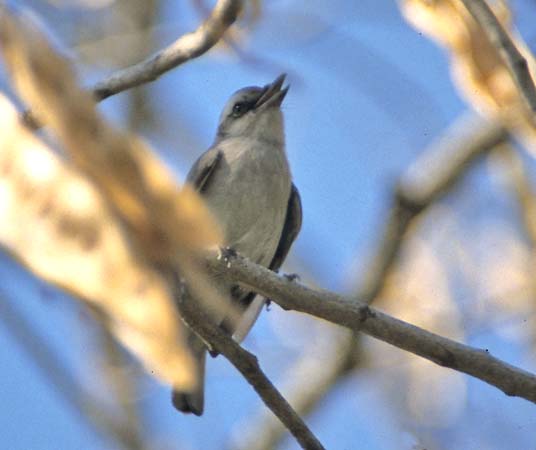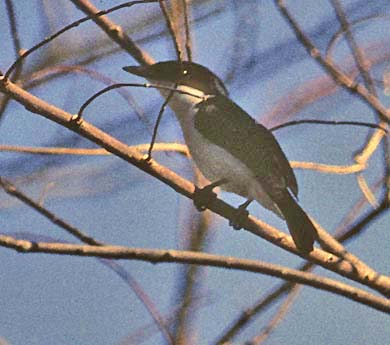| |
WOODSHRIKES & ALLIES Tephrodornithinae |
- 8 species in tropical Asia and Africa
- DR personal total:6 species (75%), 2 photo'd
|
 The
Tephrodornithinae — woodshrikes, flycatcher-shrikes and shrike-flycatchers —
are small shrike-like birds in the forests of tropical
Asia. The most common and widespread may be Common Woodshrike
(left), which ranges from Pakistan to southeast Asia. These are
typically birds of mid-canopy, tame but unobtrusive, in lowland
forests. Woodshrikes are in the genus Tephrodornis, from which the subfamily takes its name, and there are four species: Common, Large T. gularis (India to Java), and the recently split Malabar T. sylvicola (in s.w. India, split from Large) and Ceylon T. affinis (endemic to Sri Lanka, split from Common). The
Tephrodornithinae — woodshrikes, flycatcher-shrikes and shrike-flycatchers —
are small shrike-like birds in the forests of tropical
Asia. The most common and widespread may be Common Woodshrike
(left), which ranges from Pakistan to southeast Asia. These are
typically birds of mid-canopy, tame but unobtrusive, in lowland
forests. Woodshrikes are in the genus Tephrodornis, from which the subfamily takes its name, and there are four species: Common, Large T. gularis (India to Java), and the recently split Malabar T. sylvicola (in s.w. India, split from Large) and Ceylon T. affinis (endemic to Sri Lanka, split from Common).
Woodshrikes
and flycatcher-shrikes have traditionally been placed among the
cuckoo-shrikes [Campephagidae], but it is now known they arose in the
vangid lineage; Fuchs et al. (2004), Moyle et al. (2006), and Reddy et
al. (2012). Recently it has been proposed that they — and relatives
like vangas, helmetshrikes, and philentomas — be placed together in a
broadened Vangidae family (Reddy et al. 2012). |
 What
apparently happened is that the ancestors of bush-shrikes, batises, and
vangas arose in Africa and spread outward. The
molecular evidence is that three 'core' lineages arose in Africa: (a)
the bush-shrikes, (b) the
batises and wattle-eyes, and (c) the rest of the malaconotoids; e.g.
Fuchs et al. (2004). The helmet-shrikes,
vangas, and woodshrikes/shrike-flycatchers are all on the same
evolutionary branch.
Fuchs et al. (2006) and Moyle et al. (2006) provided evidence for a
split of the groups (helmetshrikes in Africa, woodshrikes in Asia) while vangas
evolved in
Madagascar. Some of these "bush-shrike-like" ancestors reached Asia
(whether directly via the Middle East or over the ocean via Madagascar
is unknown) and
diversified. Presumably many became extinct over the eons of ice ages
and the movement of tectonic plates, leaving only a remnant handful in
tropical Asia. Although the birds spread from India to Bali, none
apparently crossed Wallace's line. What
apparently happened is that the ancestors of bush-shrikes, batises, and
vangas arose in Africa and spread outward. The
molecular evidence is that three 'core' lineages arose in Africa: (a)
the bush-shrikes, (b) the
batises and wattle-eyes, and (c) the rest of the malaconotoids; e.g.
Fuchs et al. (2004). The helmet-shrikes,
vangas, and woodshrikes/shrike-flycatchers are all on the same
evolutionary branch.
Fuchs et al. (2006) and Moyle et al. (2006) provided evidence for a
split of the groups (helmetshrikes in Africa, woodshrikes in Asia) while vangas
evolved in
Madagascar. Some of these "bush-shrike-like" ancestors reached Asia
(whether directly via the Middle East or over the ocean via Madagascar
is unknown) and
diversified. Presumably many became extinct over the eons of ice ages
and the movement of tectonic plates, leaving only a remnant handful in
tropical Asia. Although the birds spread from India to Bali, none
apparently crossed Wallace's line.
Shrike-flycatchers in the genera Megabyas & Bias remain African birds in this lineage. These are African Shrike-flycatcher Megabyas flammulatus and Black-and-white Shrike-flycatcher Bias musicus. The remaining Asian vestiges of this African-evolved group are two species of flycatcher-shrike, genus Hemipus, including the Sundaic endemic Black-winged Flycatcher-shrike (right), photographed near the end of its range in eastern Java. Bar-winged Flycatcher-shrike H. picatus
ranges from India to Sumatra and Borneo. These are birds of open
forest, restless and active, and in that sense not unlike the remnant
African species of shrike-flycatcher. Together, the set is now assigned
to this new subfamily, the Tephrodornithinae. |
| |
Photos: The Common Woodshrike Tephrodornis pondicerianus was at Sultanpur Jheel, India, in March 2001. The Black-winged Flycatcher-Shrike Hemipus hirundinaceus was at Baluran NP, Java, Indonesia, on 31 Aug 1988. Photo © Don Roberson; all rights reserved.
Bibliographic note: There is no "family book" for this newly described subfamily, and the species were assigned to "traditional" families in the Handbook of the Birds of the World project.
Literature cited:
Fuchs,
J., R.C.K. Bowie, J. Fjeldså, and E. Pasquet. 2004. Phylogenetic
relationships of the African bush-shrikes and helmet-shrikes
(Passeriformes: Malaconotidae). Molec. Phylog. Evol. 33: 428-439.
Fuchs,
J., J. Fjeldså, and E. Pasquet. 2006. An ancient African
radiation of corvoid birds (Aves: Passeriformes) detected by
mitochondrial and nuclear sequence data. Zoologica Scripta 35: 375-385.
Moyle, R.G., J. Cracraft, M. Lakim, J. Nais,
and F.H. Sheldon. 2006. Reconsideration of the phylogenetic
relationships of the enigmatic Bornean Bristlehead (Pityriasis gymnocephala).
Molec. Phylog. Evol. 39: 893-898.
Reddy,
S., A. Driskell, D.L. Rabosky, S.J. Hackett, and T.S. Schulenberg.
2012. Diversification and the adaptive radiation of the vangas of
Madagascar, Proc. Royal Soc. B 279: 2062-2071.
|
|
|

 The
Tephrodornithinae — woodshrikes, flycatcher-shrikes and shrike-flycatchers —
are small shrike-like birds in the forests of tropical
Asia. The most common and widespread may be Common Woodshrike
(left), which ranges from Pakistan to southeast Asia. These are
typically birds of mid-canopy, tame but unobtrusive, in lowland
forests. Woodshrikes are in the genus Tephrodornis, from which the subfamily takes its name, and there are four species: Common, Large T. gularis (India to Java), and the recently split Malabar T. sylvicola (in s.w. India, split from Large) and Ceylon T. affinis (endemic to Sri Lanka, split from Common).
The
Tephrodornithinae — woodshrikes, flycatcher-shrikes and shrike-flycatchers —
are small shrike-like birds in the forests of tropical
Asia. The most common and widespread may be Common Woodshrike
(left), which ranges from Pakistan to southeast Asia. These are
typically birds of mid-canopy, tame but unobtrusive, in lowland
forests. Woodshrikes are in the genus Tephrodornis, from which the subfamily takes its name, and there are four species: Common, Large T. gularis (India to Java), and the recently split Malabar T. sylvicola (in s.w. India, split from Large) and Ceylon T. affinis (endemic to Sri Lanka, split from Common).  What
apparently happened is that the ancestors of bush-shrikes, batises, and
vangas arose in Africa and spread outward.
What
apparently happened is that the ancestors of bush-shrikes, batises, and
vangas arose in Africa and spread outward.